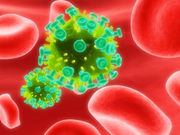Findings in children exposed to nevirapine for prevention of mother-to-child transmission
TUESDAY, Nov. 3, 2015 (HealthDay News) — For nevirapine-exposed children with HIV achieving initial viral suppression with ritonavir-boosted lopinavir-based therapy, transition to efavirenz-based therapy is not inferior to continuing ritonavir-boosted lopinavir-based therapy, according to a study published in the Nov. 3 issue of the Journal of the American Medical Association.
Ashraf Coovadia, M.B.Ch.B., from the University of Witwatersrand in Johannesburg, and colleagues conducted a randomized noninferiority trial involving 300 HIV-infected children exposed to nevirapine for prevention of mother-to-child transmission. Two hundred ninety-eight children with initial viral suppression were randomized to switch to efavirenz-based therapy (150 children) or to continue ritonavir-boosted lopinavir-based therapy (148 children); 98 percent were followed-up at 48 weeks after randomization.
The researchers found that the Kaplan-Meier probability of viral rebound by 48 weeks was 0.176 and 0.284 in the efavirenz and ritonavir-boosted lopinavir groups, respectively. The probabilities of viral failure were 0.027 and 0.020 in the efavirenz and ritonavir-boosted lopinavir groups, respectively. For viral rebound and viral failure, the risk differences were 0.107 and −0.007, respectively. For both end points, efavirenz was not inferior to ritonavir-boosted lopinavir (P < 0.001). CD4 cell percentage was 2.88 percent higher in the efavirenz group versus the ritonavir-boosted lopinavir group at 48 weeks.
“This study provides evidence to support the safety and efficacy of switching to efavirenz, the recommended drug for children older than 3 years, among children with viral suppression,” the authors write.
Copyright © 2015 HealthDay. All rights reserved.








